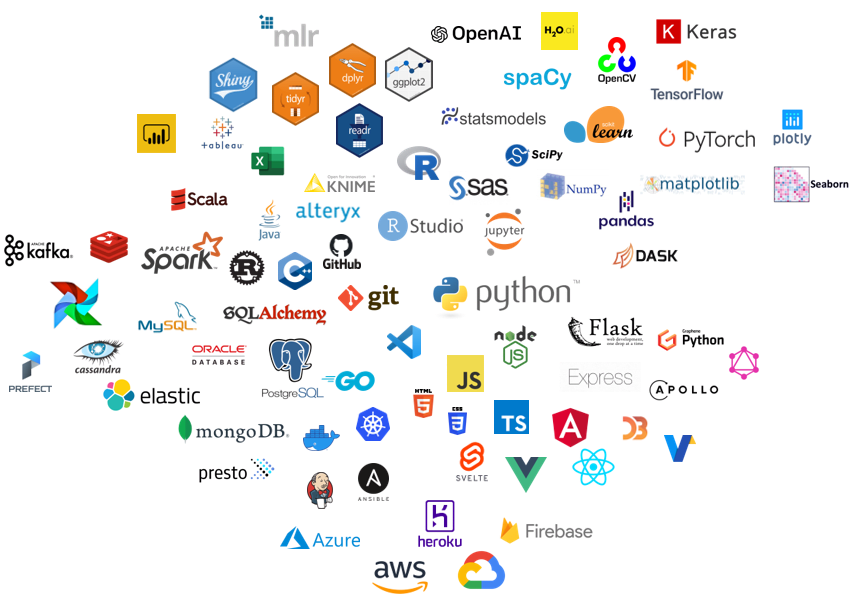Introduction
What is a tech stack
A tech stack is a set of technologies underneath a development project. It is a combination of programming languages, servers, software, UI/UX solutions, frameworks, and tools used to build and run a web or mobile app.
Examples of a tech stack
There are no two identical tech stacks.
The one of Facebook, for example, consists of over 30 tools, among coding languages and frameworks being CSS, PHP, JavaScript, ReactJS, and HTML. Airbnb, on the other hand, uses Java, MySQL, JavaScript, and Ruby on Rails.
 Different services used in the tech stack.
Different services used in the tech stack.
Why your tech stack is important
Indeed, the tech stack is, as the name suggests, technical in its nature but that doesn’t imply that non-developers can ignore it. In fact, it’s crucial for every member of a team involved in decision-making to be aware of the tech stack and its influence on the company’s future. Generally, the right tech stack is the key to the success of your idea, while the wrong set of development technologies may lead to failure.
Keep in mind that it is important to make decisions about the tech stack prior to the major building of your product. Of course, you can make changes in the set of tools when you realize that you need something different, but it’s quite difficult and usually involves a huge investment of both money and time.
Another reason for thinking of your tech stack in advance is that it can affect the scalability of your product. When you start, be reasonably ambitious and decide how and to what extent you want to scale in the future. Since different tech stacks serve different purposes, choose the one that corresponds to your needs the best.
How to choose the right tech stack
Unless you have experience in product development, you are probably not familiar with choosing the only right tech stack for your project. But don’t worry — that’s totally okay. If you’re an ideas person, you won’t have to dig into the code, but if you are the driving force of the product creation, you still need to be sure that major decisions are reasonable.
There are several basic questions that you have to answer to choose the right tech stack.
They include:
- What is the purpose of your product? That is, how and where your customers will use the product. Will the app exist on desktop or mobile? Or is it a news site that will get millions of visitors every day?
- Do you want to develop a scalable product or the one that can be deployed as quickly as possible? Which programs would you like to use: client-side ones that are familiar to many, like Wordpress or HTML, or maybe you want to target a more technologically advanced market?
- How much money are you ready to spend on product development? In case you are limited in terms of budget, you may want to use more common programming languages for cheaper hiring and search for cheap or even free solutions. But be reasonable — don’t save on the costs to the detriment of your product’s quality.
- Are you going to change the functionality of your product in the future? If the answer is yes, better choose an easily extensible language to make the process easier. However, keep in mind that the upkeep costs of such a product will almost certainly be higher.
That stack can be formally divided into 2 parts, i.e. the client-side and the server-side.
Frontend
The client-side or front-end provides interaction between the user and the server-side, that is, backend. Front-end technologies are responsible for everything the user sees on the screen. Front-end development provides configuration, optimization, and operation of all interface elements.
Frontend technologies include:
- HTML/HTML5
- CSS
- JavaScript
- UI-frameworks and libraries: React, Angular, Vue, Node.js, jQuery...
Backend
The backend is the server part of the application with which the user does not contact directly. Back-end stores and manages data, and is also responsible for the correct operation of the client-side.
Backend technologies include:
- Operating system;
- Web server: Nginx, Apache
- Programming languages: C#, Java, PHP, Python, Objective-C...
- Various frameworks build over programming languages: Node.js, .NET, Django...
- Databases: Microsoft SQL Server, MySQL, PostgreSQL, Oracle...
- Cloud infrastructures and services: AWS, Microsoft Azure, Google Cloud, Heroku...